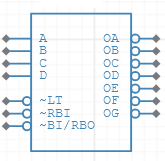

The use of IC will also be by the resistors because the most operating voltage uses with CMOS/TTL devices are 5 volts. Therefore, The IC will always depend on which type of display we are using. Multiple ICs are useable with the display to operate with only a small number of pins. Therefore, it depends on the designer which methods the system can use at a cheap cost. The above truth table will decide the output from the input pins. To use the LED there are two methods, one is IC which will take the 4-inputs and will able to generate the output data from 0-9 and it can also show some alphabets on the 7-segments. It also uses the resistor for power protection. The LED’s power limit is according to the other simple LED lights. The light from one led won’t affect the other and gives a clear and clean output. The specific dark color case is used to limit the LED light to itself. Whenever any pin gets the power input of specific voltages then it starts glowing. Then all the other pins come out of the package as a single pin for each LED. That pin decides when the anode is common or cathode. In the device, all the LEDs are placed at a 90-angle from minium two LEDs. In the 7-segment display, the simple LEDs uses to display the decimal character. Pin10 g Power input on pin10 lights up the middle led.


Pin9 f Top-left led lights up through pin9. Pin8 com Pin8 is a second common ground pin, works like same as pin3. Pin7 a The top led of the 7-segments is at pin7. Pin6 b It controls the right top led light. Pin4 c Pin4 light up the bottom right led to the display Pin5 DP There is a decimal point on the 7-segment which uses the pin5 to light up. It depends on the type of the 7-segment either it is the common cathode or anode. Pin3 com This pin will common with ground/power. Pin2 d Pin2 helps to light up the bottom-most led. PINS Details Pin1 e The first pin1 connects with the left bottom LED of the display. This section lists the description of all pins for both common anode and common cathode types. 7- Segment Display Pinout Diagram Details


 0 kommentar(er)
0 kommentar(er)
